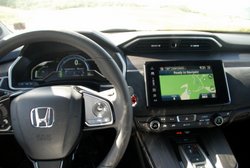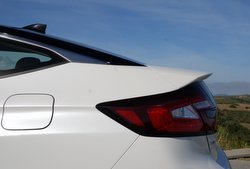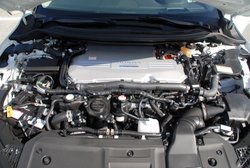Welcome To Space Age Transportation
We have driven the future—and it feels a lot like today. We recently drove the production version of the 2017 Honda Clarity, the third entry in the hydrogen fuel cell field (after the Hyundai Tuscon and the market leader, Toyota Mirai). It’s a real car that should help move fuel cell cars incrementally closer to the automotive mainstream.

Let’s move past the old narrative that hydrogen fuel cell cars are the transportation of the future—and always will be—and focus on the cars available today. The Honda Clarity demonstrates the exciting aspect of this technology, but also shows the struggle these “future” cars have to fit into the mainstream.
This is the third generation of Honda’s fuel cell cars (the fuel cell “engines” have gone through many more generations during the 20 years of development as all new technologies do). The Gen 1 was the Honda Plus FCEV, which used the company’s electric car platform to get early models out on the road for testing. It was a mundane package, but it drove great.
The second generation, now named Clarity, was a big car, great-looking in the subdued Honda style, but still not ready for prime time. A few were made available for lease to select fuel cell enthusiasts. When we drove it, much like our experience with the first generation, it impressed us with the refinement of it as a functional car. It was fast, smooth and felt ready to hit the showroom.
Now we have Gen 3–also Honda Clarity. It is all new, a more radical design than the previous generation, but still governed by Honda’s conservative approach. It also feels identical to a mainstream Honda in every way except its powertrain. The tip-off that we’re still not in the mainstream comes if you really want to buy one–you still can’t at Honda (the Toyota Mirai can be purchased). For now, the Clarity is a lease-only vehicle, like the Mirai only available in the areas of California that have the initial stations of the still nascent fueling network.

The advances through the years have shrunk the fuel cell stack size, increased its power and durability and reduced its costs. That’s great, but this advancement also has precipitated a dramatic redesign with each generation since optimal packaging is necessary to reduce weight and make sure the performance is at the top of its game. Challenging doesn’t begin to describe it. It’s not a problem for a concept car every couple years, but for volume production, that’s a big hurdle. It’s one that will likely keep all fuel cell cars at small volumes until the engineers feel like they’ve got a package that will attract a larger audience.

So what’s an automaker to do. Put a stake in the ground and launch. Hyundai took a short cut, dropping a fuel cell powertrain in its Tucson SUV and hitting the market first. It also was only available for lease. Toyota followed with a bigger splash—the purpose-designed Mirai, which incorporated some Prius styling hints/synergy, but it is clearly its own vehicle. And you can purchase as well as lease it.
Now comes Honda. Rather than carry forward with the slick, if not instantly recognizable design of the Clarity, Honda laid out a course like its rival Toyota with a unique, edgy design. It works. Of course, the company has announced it’s sharing that design with new battery electric and plug-in hybrid models, but it should help make a mark.
For all its future technology under the hood, the 2017 Honda Clarity drives like most contemporary electric cars. It’s responsive with great low-end torque. The true five-passenger, four-door sedan comes well-equipped with all of the modern technology expected in a car, such as a dual-zone climate control, an infotainment system that includes a 540-watt/12-speaker audio system and an eight-inch high-res touch screen with navigation that includes hydrogen refueling stations. Additionally, the system is Apple CarPlay and Android Auto compatible. The fuel-cell vehicle also features the Honda Sensing package of safety equipment and the LaneWatch blind-spot monitoring system. You do lose some trunk space because of the hydrogen storage tank placed behind the back seat; the 11.8 cubic feet of trunk space in the Clarity is almost five cubic feet less than the subcompact Fit.

While it is an electric drive car, the Clarity has a 350+ mile range between fill-ups (one of the big advantages of a hydrogen-fueled electric car compared to a battery-powered one). The limitation, of course, is there are not that many fueling stations (28 are open in California as of this writing and that number is expected to double within a year or two). Less this cramp your style, Honda and its competitors include free fuel in the price of their fuel cell cars.
The lease price of the Clarity is only a few dollars different than the Mirai, which is to be expected at this stage of the game. For those who qualify and live near the 12 California dealers that will be the initial market, the 2017 Honda Clarity can be leased for $369/month with $2,868 down. Not a bad deal to drive the future.
Related Stories You Might Enjoy:
First Drive: 2016 Toyota Mirai
News: Toyota Mirai Fuel Cell Car Hits the Market
News: Honda Introduces Clarity Fuel Cell
2014 LA Auto Show: A Hydrogen Milestone
Disclosure:
Clean Fleet Report is loaned free test vehicles from automakers to evaluate, typically for a week at a time. Our road tests are based on this one-week drive of a new vehicle. Because of this we don’t address issues such as long-term reliability or total cost of ownership. In addition we are often invited to manufacturer events highlighting new vehicles or technology. As part of these events we may be offered free transportation, lodging or meals. We do our best to present our unvarnished evaluations of vehicles and news irrespective of these inducements.
Our focus is on vehicles that offer the best fuel economy in their class, which leads us to emphasize electric cars, plug-in hybrids, hybrids and diesels. We also feature those efficient gas-powered vehicles that are among the top mpg vehicles in their class. In addition, we aim to offer reviews and news on advanced technology and the alternative fuel vehicle market. We welcome any feedback from vehicle owners and are dedicated to providing a forum for alternative viewpoints. Please let us know your views at publisher@cleanfleetreport.com.

20 thoughts on “First Drive: 2017 Honda Clarity Fuel Cell Electric”